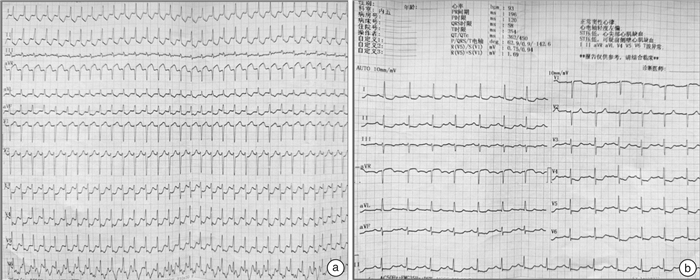A case of atrioventricular nodal reentrant tachycardia with the left inferior extension and the atrial working myocardium in the circuit
-
摘要: 经左侧延伸传导的房室结折返性心动过速病例少见,本文报道1例左侧延伸前传突破至左心房,经心房肌介导形成折返的偏心逆传慢快型病例,回顾诊治经过并结合文献复习,探讨折返通路推理、消融靶区及消融终点选择等问题,以期提高对复杂少见房室结折返性心动过速的诊治水平。
-
关键词:
- 房室结折返性心动过速 /
- 慢径 /
- 快径 /
- 导管射频消融
Abstract: Atrioventricular nodal reentrant tachycardia(AVNRT) with the left inferior extensions of the atrioventricular node being the substrates of the slow pathway is rare in clinical practice. In this case the left extension might serve as anterograde limbs and the left atrial working myocardium participated in the circuit. We expect to improve the diagnosis and treatment of difficult cases of AVNRT by discussing the exact location of reentry pathway and the ablation target zone and optimal end points. -

-
[1] Stavrakis S, Jackman WM, Lockwood D, et al. Slow/fast atrioventricular nodal reentrant tachycardia using the inferolateral left atrial slow pathway: role of the resetting response to select the ablation target[J]. Circ Arrhythm Electrophysiol, 2018, 11(9): e006631. doi: 10.1161/CIRCEP.118.006631
[2] Anderson RH, Sanchez-Quintana D, Mori S, et al. Re-evaluation of the structure of the atrioventricular node and its connections with the atrium[J]. Europace, 2020, 22(5): 821-830. doi: 10.1093/europace/euaa031
[3] Katritsis DG. A unified theory for the circuit of atrioventricular nodal re-entrant tachycardia[J]. Europace, 2020, 22(12): 1763-1767. doi: 10.1093/europace/euaa196
[4] Katritsis DG, Calkins H, Anderson RH. The specialized atrioventricular ring tissues participate in the circuit of atrioventricular nodal reentrant tachycardia[J]. J Am Heart Assoc, 2021, 10(22): e022811. doi: 10.1161/JAHA.121.022811
[5] 李景东, 宣佰军. 遗传性房室传导阻滞的当前认识[J]. 临床心血管病杂志, 2021, 37(3): 193-196. https://lcxb.chinajournal.net.cn/WKC/WebPublication/paperDigest.aspx?paperID=d36fc8d1-973e-4a52-b72c-42bf35954e0e
[6] Chua K, Upadhyay GA, Lee E, et al. High-resolution mapping of the triangle of Koch: Spatial heterogeneity of fast pathway atrionodal connections[J]. Heart Rhythm, 2018, 15(3): 421-429. doi: 10.1016/j.hrthm.2017.10.030
[7] Zheng Y, Xia Y, Carlson J, et al. Atrial average conduction velocity in patients with and without paroxysmal atrial fibrillation[J]. Clin Physiol Funct Imaging, 2017, 37(6): 596-601. doi: 10.1111/cpf.12342
[8] Katritsis DG, Marine JE, Katritsis G, et al. Spatial characterization of the tachycardia circuit of atrioventricular nodal re-entrant tachycardia[J]. Europace, 2021, 23(10): 1596-1602. doi: 10.1093/europace/euab130
[9] Vaidya VR. Catheter ablation for atrioventricular nodal reentrant tachycardia: When all is not right, ablate what is left[J]. Indian Pacing Electrophysiol J, 2021, 21(1): 11-13. doi: 10.1016/j.ipej.2021.01.005
[10] Contractor T, Swamy P, Prasad V, et al. Coronary artery injury during ablation of typical atrioventricular nodal reentrant tachycardia: Report of a rare complication and review of literature[J]. Heart Rhythm Case Rep, 2020, 6(9): 632-636.
[11] Katritsis DG, Zografos T, Siontis KC, et al. Endpoints for successful slow pathway catheter ablation in typical and atypical atrioventricular nodal re-entrant tachycardia: A Contemporary, Multicenter Study[J]. JACC Clin Electrophysiol, 2019, 5(1): 113-119. doi: 10.1016/j.jacep.2018.09.012
-





 下载:
下载:


